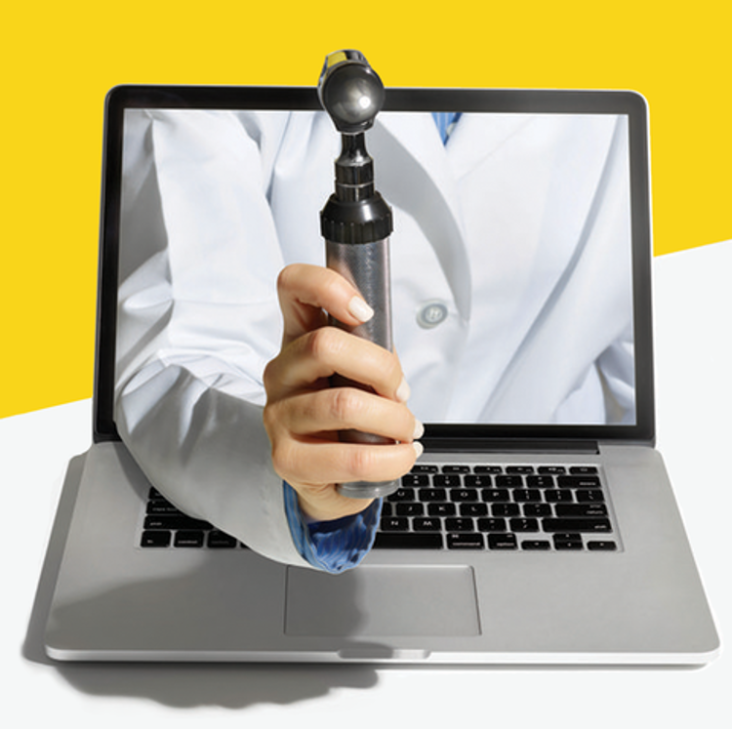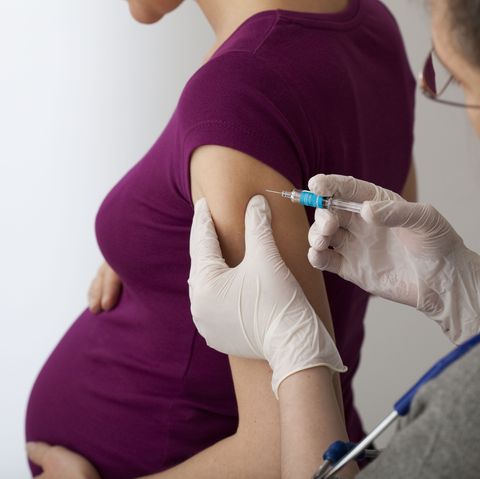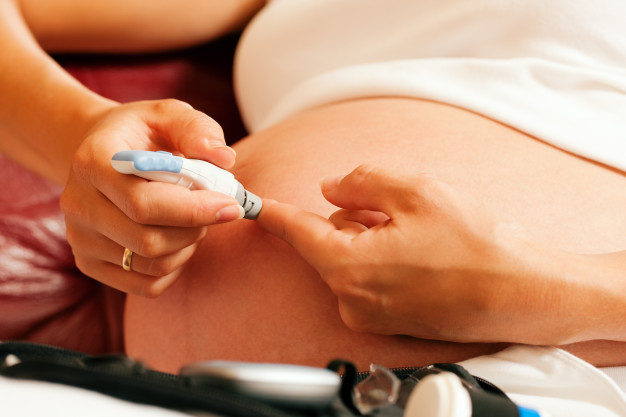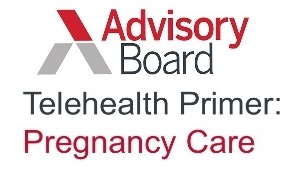Click on the link below to see the story Womens Telehealth founders Tanya Mack and C. Anne Patterson, M.D. co-wrote on COVID-19 and Pregnancy beginning on Page 32.
Click on the link below to see the story Womens Telehealth founders Tanya Mack and C. Anne Patterson, M.D. co-wrote on COVID-19 and Pregnancy beginning on Page 32.

Seeing a doctor digitally is on the rise, but should you?
Getting to the nearest high-risk pregnancy specialist was an ordeal for Tara Perez, a 35-year-old with type 1 diabetes. Tara lives in Cartersville, GA, a small town that can be up to three hours from Atlanta during rush hour. Because of her condition, it was critical for her to see this doctor regularly.
Fortunately, Tara’s local ob/gyn teamed with an Atlanta telehealth company, so every few weeks when she went for her checkup, she was also able to video-chat with maternal-fetal doctor Anne Patterson, M.D. Skipping the long-distance drive meant that the appointments didn’t take much time away from Tara’s home fragrance consulting business. Most important, it allowed her to have top-notch medical care.
The ability to offer specialty medical care outside of a big city is a key reason that telehealth (sometimes called telemedicine) has taken off in recent years. What’s fueling the surge: increased access to health care and improvements in technology, such as a secure flow of information. These allow health care providers to do things they couldn’t 25 years ago, like get near-instantaneous results for ultrasounds, EKGs, and other tests.
What a virtual appointment is like
Last year, some 7 million Americans accessed a doctor via a screen. The number of these live video appointments grew sixfold from 2015 to 2018, according to Rock Health, a fund that invests in health technology companies, and is expected to keep rising. At the same time, stores like Walgreens, Rite Aid, and CVS are starting to offer urgent-care video link-ups in some locations.
While insurance reimbursements for remote treatment vary from state to state and plan to plan, some 96% of large companies offer a telehealth benefit to employees.
Patients who have established relationships with doctors or therapists may prefer to download an app to talk to them rather than fight for an appointment. For other patients, the key is saving time—and not missing out on earnings to head to an in-office appointment.
Beyond convenience, research shows that telehealth can be as effective as in-person doctor visits. When 50 multiple sclerosis patients in a University of California study saw a new-to-them neurologist via video, all said their appointment satisfied their goals (e.g., understanding test results or adjusting meds), and three avoided a trip to the ER because the doctor was able to assess and treat them remotely.
When technology isn’t enough
Of course, there are situations in which telehealth is not appropriate. If you’re having an asthma attack or a cardiac emergency, for example, you should head to the ER, and some less dire conditions are also better diagnosed in person. In some remote situations, both physicians and patients may find the distance hard to bridge. “If someone we’ve been helping loses a pregnancy, the doctor can’t reach through the camera to give them a hug,” Mack says.
Is telehealth the future?
With access to the technology and a little practice, though, doctors say they can usually give their patients what they need. Instead of bedside manner, “we call it ‘webside manner,’” says David Mishkin, M.D., medical director of Baptist Health’s telemedicine program. “Doctors are beginning to see that this is part of the future for improving access and expanding the delivery of health care,” Dr. Mishkin says. If it offers patients quality care at an affordable price, it’s a future we can all embrace.
Read full Article: https://www.prevention.com/health/a29490042/what-is-telehealth/

August is National Immunization Awareness Month. It’s a great time for Women’s Telehealth to stress the importance of influenza (flu) vaccination for all moms-to-be, during any trimester. Both the CDC and the American College of Obstetricians and Gynecologists have recommended for years that pregnant women and women who are breastfeeding get the flu vaccine.
Vaccines are made with the highest of safety standards. The influenza vaccine has been proven safe and effective and has not been known to cause pregnancy problems or birth defects. The U.S. FDA approves all vaccines and the CDC monitors all approved vaccines regularly.
Pregnant women are a high risk group for flu due to normal changes in the immune system during pregnancy. Flu is more likely to cause severe illness in pregnant women than in women of reproductive age who are not pregnant. Pregnant women who contract the flu are also at a higher risk for complications of pregnancy such as preterm labor. A 2018 study showed that getting a flu vaccine while pregnant reduced a pregnant women’s risk of getting hospitalized with the flu by 40%.
When pregnant, the flu vaccine does “double duty” by protecting the baby as well. When a pregnant woman gets the flu vaccine, she makes protective antibodies that are transferred to baby. Infants younger than 6 months are at high risk for serious flu-related complications, but once born, are not approved for influenza vaccination until 6 months or older.
Flu vaccines are administered to adults in two ways: injection (shot) into the arm muscle and nasal spray that is inhaled. The shot contains the flu virus in an inactivated form so there’s no risk of it causing the disease. The shot therefore is the recommended form of influenza vaccine during pregnancy. The nasal spray is “live” flu virus and is NOT recommended for pregnant women.
Since the types of virus that can cause flu change, annual flu vaccination is recommended. The side effects of most vaccines are mild and last only a day or two. However, if you have any concerns about side effects after you receive the flu vaccine, consult your obstetrician.
If you are pregnant and think you have the flu, contact your obstetrician right away. Some symptoms of the flu include: fever, chills, body ache, headache, fatigue, cough, sore throat or runny nose. Antiviral medication is available by prescription and has value if taken within 48 hours of the onset of flu. This medicine will not prevent flu. but often shortens the length and severity of flu. You should also contact your obstetrician if you think you may have come in contact with someone who has the flu.
For more information on Pregnancy and Flu visit: https://www.acog.org/Patients/FAQs/The-Flu-Vaccine-and-Pregnancy?IsMobileSet=false or https://www.cdc.gov/flu/highrisk/qa_vacpregnant.htm
Tanya Mack, President

An 18 year old patient presented in a rural area to the local OB physician when she was 16 weeks pregnant. Her OB history showed she had been diagnosed with Type I Diabetes at age 5. She had been seeing a local endocrinologist but was told he would not follow her and manage her insulin during pregnancy.
The close diabetic monitoring required throughout the pregnancy would need to be provided by a Maternal-Fetal Specialist. Because the closest one was approximately 1 ½ hours from the patient’s home, she was referred to Women’s Telehealth by her local OB physician for co-management. Women’s Telehealth provided MFM care through telemedicine visits.
Of additional concern was that the patient was noted to be non-compliant in her insulin regime and diabetic care.
. . . . . . . . . . . . . . . . . . . . . . . . . . . . . . . . . . . . . . . . . . . . . . . . . . . . . . . . . . . . . . . . . . . . . . .
The prevalence of diabetes in pregnancy in the U.S. is increasing. Pre-existing, Type I diabetes confers an increased and more significant risk to both mom and baby than gestational diabetes. Tight blood sugar control is critically important at all stages of pregnancy. Uncontrolled diabetes in pregnancy can lead to such complications as fetal anomalies, pre-eclampsia, fetal demise, macrosomia, neonatal hypoglycemia and spontaneous abortion.
To learn more, visit: https://www.cdc.gov/pregnancy/diabetes-types.html
. . . . . . . . . . . . . . . . . . . . . . . . . . . . . . . . . . . . . . . . . . . . . . . . . . . . . . . . . . . . . . . . . . . . . . .
Our goal in sharing patient case stories is to show the role and possibilities Women’s Telehealth plays in accessing high risk situations and to help turn patient and OB provider concern into the best possible care plans and outcomes for mom’s and their babies. For more information, call our office at: 404.478.3017

How to successfully manage the complexities of gastroschisis in pregnancy is the focus of this Women’s Telehealth patient story. [Pictured above: Gastroschisis Baby – Post Op]
At the anatomy ultrasound scan at 17 weeks, the OB physician found that his 24 year old Caucasian patient had a suspected gastroschisis.
Gastroschisis is a birth defect in which the fetus’ intestines and/or stomach protrude outside the abdominal wall. A baby with this condition requires immediate surgery after birth to place the organs in the proper place in the abdominal cavity and close the hole in the abdominal wall. Hospitalization is also needed for an extended period of time to ensure that the baby’s feeding and digestive tract are functioning well. Most babies with appropriate care and surgery at birth will grow up to have normal lives. Successful outcomes often depend on early identification of this birth defect and preparing for surgery upon birth.
In addition to the suspected gastroschisis, other complicating factors included mom’s obesity, pregnancy-induced hypertension, low amniotic fluid, abnormal cervix and active kidney disease. The mom-to-be also needed an extra dose of oversight and compassion due to the loss of a baby during a previous pregnancy, caused by open neural tube defect.
The mom-to-be was referred by the OB physician to Women’s Telehealth maternal-fetal medicine (MFM) physicians for diagnosis and collaborative pregnancy management. Women’s Telehealth was asked to manage BOTH infant and maternal pregnancy complications.
. . . . . . . . . . . . . . . . . . . . . . . . . . . . . . . . . . . . . . . . . . . . . . . . . . . . . . . . . . . . . . . . . . . . . . . . . . . . . . . . . . . . . . . . . . . . . . . . . .
The CDC estimates that Gastroschisis affects 1 in every 1,900 babies born in the U.S. each year. The cause of this birth defect is currently unknown but researchers have speculated that potential causes may be adaptations in genes and/or the lifestyle or environment of the mother. Young, Caucasian women are the most common population to be at risk. For more information about this condition visit: https://www.cdc.gov/ncbddd/birthdefects/gastroschisis.html
. . . . . . . . . . . . . . . . . . . . . . . . . . . . . . . . . . . . . . . . . . . . . . . . . . . . . . . . . . . . . . . . . . . . . . . . . . . . . . . . . . . . . . . . . . . . . . . . . .
WT partners with OB/GYN physicians and healthcare facilities to provide the highest level of Maternal-Fetal Medicine (MFM) available through telemedicine. WT provides services in local hospitals, doctor’s offices and government clinics.
Our goal in sharing patient case stories is to show the role and possibilities Women’s Telehealth plays in accessing high risk situations and to help turn patient and OB provider concern into the best possible care plans and outcomes for moms and their babies. For more information, call our office at: 404.478.3017

This is National Breastfeeding Week in the U.S.! Women’s Telehealth encourages moms to breastfeed, whether you are a first time or experienced mom with a new baby. With that thought in mind, Women’s Telehealth has collected some “Top Tips” to get comfortable with breastfeeding.
For more info on breastfeeding visit: http://peapodnutrition.org/


As part of July Group B Strep Awareness Month, Women’s Telehealth encourages all pregnant women to make sure they complete their Group B Strep testing as part of routine prenatal care.
Group B Streptococcus (GBS) lives in the body naturally and it is a bacteria normally found in 25% of health adult women’s rectum or vagina. Women who test positive for GBS are considered “colonized” or a “carrier.”
GBS is not normally harmful to the mother, but can be harmful to the newborn. A pregnant woman can pass on this infection to the baby during delivery. Not every mom will have symptoms of a GBS infection and not every baby born to a mom with a GBS infection will become ill. While GBS disease can be deadly, there are steps pregnant women can take to help protect their babies.
The CDC recommends all pregnant women get tested for GBS between 35-37 weeks gestation. The most accurate results are within a 5 week period prior to delivery. The rectum and vagina are swabbed during the antepartum OB appointment and the sample is sent to the lab for processing. The results are usually available with a few days.
Rapid screen GBS tests are also available if a woman presents at a facility to deliver and has not had a GBS test completed. If a pregnant woman tests positive, treatment is considered.
Intravenous antibiotics (usually Penicillin for non-allergic patients) are given to women who are at increased risk of having a baby who will develop GBS disease. The antibiotics help protect babies from infection, but only if given during labor. Antibiotics are administered from the onset of labor and continue every 4 hours through to delivery.
The following symptoms may indicate a higher risk of delivering a baby with GBS:
If the baby is delivered via C-section and there is no labor or rupture of membranes, antibiotic treatment is not given. About 1 out of 200 babies of moms with GBS will contract the infection without IV antibiotic treatment. With IV antibiotic treatment, the incidence of babies contracting the infection is lowered to 1 in 4,000.
Early-onset GBS occurs when a baby is infected with GBS within the 1st week of life. Roughly half of babies born with GBS infection have early- onset symptoms including: sepsis, pneumonia, meningitis, breathing problems, heart rate and blood pressure instability and GI and kidney problems. In severe cases, stillbirth may result. Approximately 5% of babies with GBS infections at birth will die.
Late-onset GBS may occur after one week to several months of age. Signs of late-onset GBS include changes in your baby’s eating habits, such as feeding poorly, refusing to eat or not waking for feeding. Changes in baby’s skin, including blue, gray or pale skin due to lack of oxygen, or blotchy or red skin may also be signs of GBS. In the U.S., late-onset GBS has been the leading cause of meningitis in newborns in the first three months of life.
Although research is continuing, there is currently no vaccine for Group B Strep infection. The best two ways to prevent GBS during the first week of a newborn’s life are:
For additional information, please visit:
https://www.cdc.gov/groupbstrep/index.html or https://www.marchofdimes.org/complications/group-b-strep-infection.aspx
Don’t put your un-born baby at risk! Learn the facts and get tested!
~Tanya Mack, President

Virtual pregnancy care spans from prenatal to postpartum care. It incorporates a variety of telehealth modalities including audiovisual visits, remote patient monitoring and “live” and asynchronous store and forward imaging.
The Advisory Board is the best practice firm helping healthcare organizations worldwide improve their performance using a combination of research, technology and consulting. They have 12 offices on 3 continents and publish to over 9,000 healthcare organization outlets.
Recently, the Advisory Board published the piece, “Telehealth Primer: Pregnancy Care.” The publication features four innovative healthcare organizations using telehealth tools to deliver different aspects of pregnancy care and their business cases and results.
Women’s Telehealth is pleased to be featured in the primer for our work in providing maternal-fetal medicine services, delivered 100% via telemedicine, to help decrease preterm labor and improve access to maternal-fetal medicine providers.
The Mayo Clinic’s OB Nest program and the University of Utah were also featured in the Primer for their work in delivering antepartum visits virtually vs. in-person visits, to improve patient satisfaction with the same clinical outcomes.
The Primer also featured the University of Pennsylvania for delivering postpartum visits via remote patient monitoring to ease post-delivery care and outcomes for new moms.
For a copy of this informative primer, visit: https://www.advisory.com/research/service-line-strategy-advisor/resources/2018/telehealth-primer-pregnancy-care

Umbilical cord blood (UCB) is rich in stem cells, which have the potential to be used to improve and save lives once they are collected and preserved for future medical use.
Over the past 30 years, since the first cord blood transplant was performed in Paris, France, the industry has continued to evolve in clinical applications. UCB is primarily banked and then available for treatment potential and compatibility. UBC can be legitimately used for treatment of over 80 diseases including:
Obstetricians have a key role in UCB as they spread awareness, counsel expectant parents about their options and also serve as the UCB collectors. It is wise not to wait until delivery to make the decision to bank cord blood as arrangements must be made with the hospital and cord blood bank in advance. UCB collection is performed immediately after birth and is safe, painless and voluntary. The delivering physician clamps and cuts the cord, collects the blood in the umbilical cord and the cord itself in a sterile, protective cup. Then, a pre-arranged courier picks it up for processing in the lab. Once it is prepared and the stem cells have been extracted, it is cryopreserved and stored or “banked” for future medical use. Recently, experts estimated there are almost 6 million cord blood units “banked.”
In the U.S., health insurance does not cover cord blood collection, processing or banking fees. Patients collecting UCB can choose to donate cord blood and have it stored in a public cord blood bank and the costs are free. Donated cord blood could help save the life of someone in need or be used for valuable medical research. Patients can also choose and pay for private UCB banking. Privately banked cord blood is stored just for the family’s future use. It may help treat a family member who is sick and needs a stem cell transplant.
Upfront costs can vary from $500 to $2,500, plus an annual storage fee of around $300-500. Recently, private UCB has sharply increased and public UCB is going down.
There is no current, scientific data how long stem cells may be “banked,” although experts have stated that preserved stem cells have no expiration date and frozen stem cells may remain so indefinitely without losing their properties once thawed.
Although many view UCB as “biological insurance,” advanced cell therapies, especially in the areas of regenerative applications such as cerebral palsy and autism, are being studied intently. In tracking “released” UCB, 50% of clinical uses have been for brain injury patients and about 26% for congenital anomalies.
Today, approximately 1:1,000 is the ratio of “used” UCB to “banked” UBC. Although there is much promise and great potential with the current and future uses of UCB, there is no guarantee on the return of banked UCB. We do know that research drives medical progress and numerous patients have achieved the benefits of banked cord blood.
For more information and to spread the news about UCB Banking during National Cord Blood Awareness Month, visit: www.parentsguidecordblood.org
~Tanya Mack, President

Unborn baby’s high birth defect risk is the focus of this Women’s Telehealth patient story.
This Pregnancy’s Challenge: In a prior pregnancy, prenatal tests indicated positive results for Downs Syndrome for this mom-to-be. Fortunately, this proved not to be the case and her baby was indeed born healthy. However, with the next/current pregnancy, the patient was extremely worried when “Quad Test” results [deleted: during her current pregnancy] reflected a 1:56 risk for Trisomy 18 and the ultrasound conducted at the local hospital was inconclusive.
Trisomy 18, also known as Edwards Syndrome, is similar to Downs Syndrome, as they are both caused by a chromosome abnormality. Unlike Downs Syndrome however, Edwards Syndrome is potentially more life-threatening during the neonatal period and early life. It was very important that the mother and unborn child receive high-risk OB Specialist care.
The Team’s Actions: Because there were no MFM Specialists in the patient’s community and it was over an hour drive to the closest one in Albany, GA, the patient opted for MFM care via telemedicine through Women’s Telehealth based in Atlanta. WT was able to offer the patient in-depth evaluation and consultations via telemedicine directly from her local OB physician’s office.
The Results:
WT’s progressive telemedicine capability, providing the right specialist at the right time, supported the patient safely through an uncertain, emotional journey. In this case, the WT team was able to allay the patient’s concerns and celebrate a positive outcome!
. . . . . . . . . . . . . . . . . . . . . . . . . . . . . . . . . . . . . . . . . . . . . . . . . . . . . . . . . . . . . . . . . . . . . . .
Birth defects are a common, critical and costly condition affecting 1 in every 33 babies born in the U.S. each year.* For more information about birth defect stats, prevention, diagnosis and aftercare, visit: https://www.cdc.gov/ncbddd/birthdefects/facts.html
*Centers for Disease Control and Prevention. Update on Overall Prevalence of Major Birth Defects–Atlanta, Georgia, 1978-2005. MMWR Morb Mortal Wkly Rep. 2008;57(1):1-5.
. . . . . . . . . . . . . . . . . . . . . . . . . . . . . . . . . . . . . . . . . . . . . . . . . . . . . . . . . . . . . . . . . . . . . . .
Our goal in sharing patient stories is to show the role and possibilities Women’s Telehealth plays in accessing and intervening in high risk pregnancies. We help turn patient and OB provider concern into the best possible care plans and outcomes for mom and their babies.
For more information, call our office at: 404.478.3017